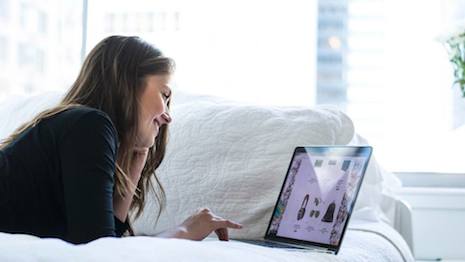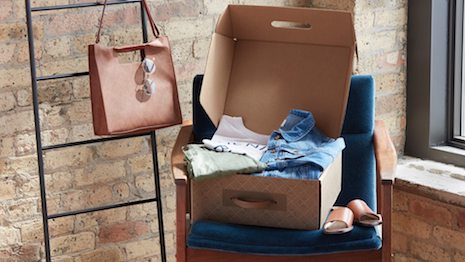 Amazon Prime Wardrobe offers a try-before-you-buy payment method. Image credit: Amazon
Amazon Prime Wardrobe offers a try-before-you-buy payment method. Image credit: Amazon
Three-quarters of consumers are interested in being able to see and try on merchandise before making a payment, according to a new report from Klarna.
One of the biggest hurdles in getting consumers to buy via ecommerce is the inability to test out items before making a financial commitment. Try-before-you-buy has the potential to remove this concern, giving consumers the ability to receive and evaluate orders before deciding to pay and keep them.
"Retailers selling luxury goods online have the opportunity to increase sales, particularly in the apparel category, by enabling consumers to bring the dressing room into their homes," said Elizabeth Bramlage, head of marketing for Klarna North America, New York. "With a try-before-you-buy option, consumers can evaluate items before they are charged, which enables them to try on the same item in different sizes and colors to make sure they are satisfied with the fit and look.
"This increased flexibility opens the door for consumers to 'window shop' in the convenience of their home and motivate them to purchase items they may have been reluctant to sample," she said.
Klarna’s online survey was conducted by Researchscape International in May. About 2,000 U.S. adults were polled.
Try and see
According to Klarna’s survey, 71 percent of respondents would use a try-before-you-buy service if it was available to them. Additionally, seven in 10 consumers would be at least somewhat apt to pick one retailer over another to take advantage of this payment method.
The survey also found that 69 percent of consumers would buy more online if they were able to test out merchandise before paying.
For fashion brands in particular, try-before-you-buy might have the potential to increase cart size. Eighty-five percent of respondents in the survey said they would order five or more items for a home try-on if they did not have to pay up front.
For apparel, try-before-you-buy was the preferred payment method of respondents, with 37 percent indicating they would rather use this service. In comparison, credit cards were indicated by 20 percent of those surveyed, while debit cards were picked by 16 percent of shoppers.
 Consumers prefer try-before-you-buy to credit. Image credit: Saks Fifth Avenue
For luxury brands in particular, being able to offer consumers more confident online purchasing may help further the growth of ecommerce.
Some brands have already rolled out services that allow consumers to decide then buy.
For instance, Net-A-Porter and Mr Porter allow their “Extremely Important People,” or EIPs, to call in a personal shopper who will select items for them. The consumer can then pick what they want to keep, and they will only be charged for those items.
Similarly, Nordstrom-owned Trunk Club’s personal stylists pick out apparel for its stylish consumers based on profiles, rather than having clients shop themselves.
Once the consumer tells Trunk Club their size, style and fit preferences, stylists hand select pieces from more than 50 high-end brands, including John Varvatos, and ship them to the customer. The client keeps what he or she likes and returns the rest with a prepaid shipping label (see story).
Consumers prefer try-before-you-buy to credit. Image credit: Saks Fifth Avenue
For luxury brands in particular, being able to offer consumers more confident online purchasing may help further the growth of ecommerce.
Some brands have already rolled out services that allow consumers to decide then buy.
For instance, Net-A-Porter and Mr Porter allow their “Extremely Important People,” or EIPs, to call in a personal shopper who will select items for them. The consumer can then pick what they want to keep, and they will only be charged for those items.
Similarly, Nordstrom-owned Trunk Club’s personal stylists pick out apparel for its stylish consumers based on profiles, rather than having clients shop themselves.
Once the consumer tells Trunk Club their size, style and fit preferences, stylists hand select pieces from more than 50 high-end brands, including John Varvatos, and ship them to the customer. The client keeps what he or she likes and returns the rest with a prepaid shipping label (see story).
 Trunk Club offers try-before-you-buy. Image credit: Trunk Club
Outside of luxury, online retail giant Amazon is continuing to undercut the traditional bricks-and-mortar model with the introduction of a try-before-you-buy service.
Dubbed Prime Wardrobe, the service is currently in BETA testing and available only to Prime customers that the retailer has selected to pilot the program. During an era where traditional department stores are facing declining sales and consumer disinterest, Amazon has only upped the ante on its fashion division’s happenings and service programs (see story).
"Any brand or retailer seeking to take advantage of offering a try-before-you-buy option will want to do their homework to find a platform that works for them as well as their customers," Ms. Bramlage said. "For the retailer, they will want to look for a system that can be integrated into their checkout as quickly and efficiently as possible.
"For consumers, the right approach will offer a frictionless means of signing up for the program, so as not to confuse and disrupt the momentum of those about to make purchases," she said.
Online opportunity
In luxury, ecommerce is growing at a faster rate than the rest of the market.
Ecommerce sales of luxury goods are growing rapidly. Today, online sales of personal luxury goods are $20 billion, making up 8 percent of total luxury sales.
By 2025, McKinsey projects this figure will more than triple to $74 billion, with about one in five luxury sales happening online (see story).
As innovations such as augmented reality and voice assistants become more mainstream, consumers are expected to move even more of their shopping online.
The majority of consumers who have shopped online using augmented reality would be willing to give up the apparel in-store buying experience entirely, according to a new report from Adtaxi. While the luxury buying process is largely still driven by physical stores, technology could make more consumers willing to forego the bricks-and-mortar experience in the coming years (see story).
"Consumers in the survey indicated one of the key reasons they shop at retail stores and not online is the ability to try on multiple items," Klarna's Ms. Bramlage said. "And 74 percent of respondents stated that being able to try items before being charged would remove the main drawback to online shopping.
"Sixty-nine percent said they would likely buy more items at an online merchant offering a try-before-you-buy option," she said.
"A try-before-you-buy option gives consumers the same piece of mind when purchasing an item online as they would from selecting it in a brick-and-mortar store," she said. "It eliminates the mystery and often felt apprehension of buying products online."
Trunk Club offers try-before-you-buy. Image credit: Trunk Club
Outside of luxury, online retail giant Amazon is continuing to undercut the traditional bricks-and-mortar model with the introduction of a try-before-you-buy service.
Dubbed Prime Wardrobe, the service is currently in BETA testing and available only to Prime customers that the retailer has selected to pilot the program. During an era where traditional department stores are facing declining sales and consumer disinterest, Amazon has only upped the ante on its fashion division’s happenings and service programs (see story).
"Any brand or retailer seeking to take advantage of offering a try-before-you-buy option will want to do their homework to find a platform that works for them as well as their customers," Ms. Bramlage said. "For the retailer, they will want to look for a system that can be integrated into their checkout as quickly and efficiently as possible.
"For consumers, the right approach will offer a frictionless means of signing up for the program, so as not to confuse and disrupt the momentum of those about to make purchases," she said.
Online opportunity
In luxury, ecommerce is growing at a faster rate than the rest of the market.
Ecommerce sales of luxury goods are growing rapidly. Today, online sales of personal luxury goods are $20 billion, making up 8 percent of total luxury sales.
By 2025, McKinsey projects this figure will more than triple to $74 billion, with about one in five luxury sales happening online (see story).
As innovations such as augmented reality and voice assistants become more mainstream, consumers are expected to move even more of their shopping online.
The majority of consumers who have shopped online using augmented reality would be willing to give up the apparel in-store buying experience entirely, according to a new report from Adtaxi. While the luxury buying process is largely still driven by physical stores, technology could make more consumers willing to forego the bricks-and-mortar experience in the coming years (see story).
"Consumers in the survey indicated one of the key reasons they shop at retail stores and not online is the ability to try on multiple items," Klarna's Ms. Bramlage said. "And 74 percent of respondents stated that being able to try items before being charged would remove the main drawback to online shopping.
"Sixty-nine percent said they would likely buy more items at an online merchant offering a try-before-you-buy option," she said.
"A try-before-you-buy option gives consumers the same piece of mind when purchasing an item online as they would from selecting it in a brick-and-mortar store," she said. "It eliminates the mystery and often felt apprehension of buying products online."
